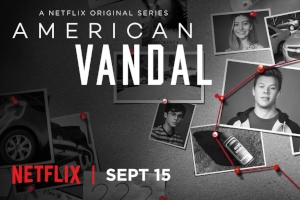“American Vandal” – an eight-episode fictional docu-mystery that dropped last fall on Netflix – explores the snicker-worthy case of someone spray-painting penises on 27 cars. And to be sure, creators Dan Perrault and Tony Yacenda intend the straight-faced talk about “dicks” and “ball hairs” and “mushroom heads” to appeal to our inner juvenile comedian.
If that was all there was to “American Vandal,” though, the joke would wear thin. But the show has a lot of layers. It parodies the storytelling of “Making a Murderer,” “Serial” and other docu-mysteries based on real-life murders. It shines a light on modern public high school life, and the “guilty until proven innocent” approach of administrative justice, in funny and serious ways. As is often the case in the 21st century, the line between parody and sober observation is tenuous.
The secret weapon of the series is the characters. “American Vandal” does for high school students and teachers what “The Office” did for office drones – although, unlike most long-running mockumentary series, “Vandal” stays consistently, believably true to the documentary style.
The title character is Dylan Maxwell (Jimmy Tatro), who is expelled from coastal California’s Hanover High for the crime. In a gruff yet immature voice, Dylan does not come off as a deep thinker in interviews conducted by documentarians Peter (Tyler Alvarez) and Sam (Griffin Gluck) – the younger stand-ins for Perrault and Yacenda, no doubt. He looks like he’s straining to explain why things like his YouTube pranks (farting on babies, humping trees in nun outfits) are funny.
A particularly great scene is when Dylan struggles to convey why he likes his girlfriend, Mackenzie (Camille Ramsey). It’s the cliché about realizing his feelings of first love, but Dylan is utterly unaware that he’s spouting clichés, and it’s great.
My favorite performance comes from Calum Worthy as Alex Trimboli, the only witness to Dylan committing the vandalism. As Peter and Sam examine Alex’s trustworthiness – one of many character-based rabbit holes they travel down – we can see Alex is trying just a bit too hard to be liked. Biting his lip, sweating and asserting his confidence with the phrase “100 percent,” he comes off as a liar and a braggart, and we expect he’s at least 50 percent aware of this. Alex is someone you’d encounter in the halls of an American high school.
Indeed, most high school archetypes are accounted for, from the pseudo-hip young teacher (Ryan O’Flanagan’s Mr. Kraz) to the senior class president who leads protests of global warming and other injustices (G. Hannelius’ Christa Carlyle) to Dylan’s friends, the Wayback Boys (which includes one girl, something that probably didn’t even occur to them), who think weed cures everything – including asthma.
“Vandal’s” humor tends to come broadly, as we marvel at Sam’s meticulous 3D computer graphics – for example, examining from which angles an alleged summer camp hand-job could be seen — and the depth of the duo’s amateur sleuthing.
In one episode, Peter and Sam pore over footage from various cellphones at the infamous “party at Nana’s.” On the surface, they are uncovering clues about where the spray-paint can came from. But playing behind it all is an insane kegger where a student’s grandmother’s house gets utterly trashed, and where Canadian exchange student Ming (Cody Wai-Ho Lee), wanting to be liked, flirts with alcohol poisoning.

The social commentary comes broadly, too. “Vandal” doesn’t lecture us about the injustice of Dylan being expelled based on his reputation; it just shows us what’s happening. “Vandal” does ultimately put a pin in the notion that you can never really know someone, recasting Dylan’s early idiocy as wisdom (“Who am I? That’s a dumb question.”).
But Perrault and Yacenda possibly aren’t even trying to make a statement about the failed premise of public schooling; they just show us how it is – or remind us, as it were.
So how does Season 1’s mystery come together? SPOILER WARNING.
In the final episode, “Vandal” does not definitely say whodunit. I give the creators credit for the mounting tension of the closing episodes, including a “Whoa!” solution that ends up being a fake-out. However, Season 1 ends without a solution, leaving us only with Peter and Sam’s fairly solid theory of who the culprits are. Why not have a tidy ending? If more of this case is planned for Season 2 (coming later this year), that’s cool, because there are more wrinkles to iron out; for example, who is the other guy Mackenzie was seeing? If this is where it ends, it’s a bit of a WTF move.
But the journey to the finish line is always engaging, both because of the mystery and the broader observations. Through wonderfully recognizable characters, “American Vandal” holds up a mirror to public education, yet it also allows us the escape route of calling it a “parody” if we’re uncomfortable with the realness of it all.

